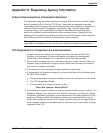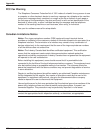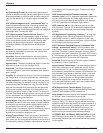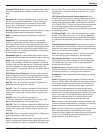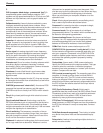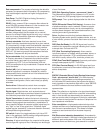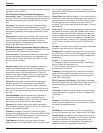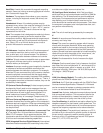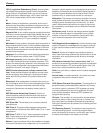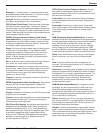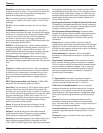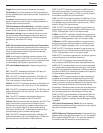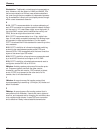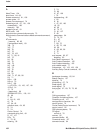
MultiModemISI Hybrid Series, ISIHI-2S 175
Glossary
Hard Disk: A metal disk covered with magnetic recording
material. Some can hold up to several gigabytes of informa-
tion. Contrast with floppy disk.
Hardware: The equipment that makes up your computer
system, including the keyboard, mouse, disk drives, and
monitor.
Hexadecimal: A base 16 numbering system used to
represent binary values. Hex uses the numbers 0-9 and the
letters A-f; usually notated by an “h” (as in “4CF h”, read as
“four charley fox, hex”). The result is that one hex digit
represents a four-bit value.
Host: The computer that is designated as retaining informa-
tion or processing power to service the needs of other
computers or terminal. Mainframes and mid-range comput-
ers are hosts, as well as PCs with powerful microproces-
sors. Often a PC on a LAN will be set up as a host to
provide LAN access for remote users.
I
I/O Addresses: Locations within the I/O address space of
your computer used by a device, such as an expansion
card, a serial port, or an internal modem. The address is
used for communication between software and a device.
Initialize: To begin anew and establish start-up parameters.
This typically involves clearing all or some part of the
device’s memory or disk space.
Interface: A common meeting ground supplied by hardware
or software to facilitate a compatible connection and
operation between two devices or programs. For example,
when two PCs are connected they use a common interface
across the physical connectors so that the signals being
sent and received are accurately interpreted. With software,
an interface is a module created to be “written to.” That is, if
two programs are written to the same interface, they can be
successfully linked together.
IPX (Internet Packet Exchange): A data transport protocol
developed by Novell used to route messages from one
node to another. Application programs that manage their
own client/server or peer-to-peer communications in a
Novell network can access IPX directly. IPX does not
guarantee the delivery of a message. Compare with SPX.
IRQ Level (Interrupt Request Level): The notification a
processor receives when another portion of the computer’s
hardware requires its attention. IRQs are numbered so that
the device issuing the IRQ can be identified, and so IRQs
can be prioritized.
ISA (Industry Standards Architecture - pronounced “ice
a”): The classic 8 or 16-bit architecture introduced with
IBM’s PC-AT computer. Due to speed constraints, IBM
introduced a restructured Micro Channel Architecture with a
32-bit bus and increased addressing capabilities.
ISDN (Integrated Services Digital Network): International
telecommunications standard for transmitting voice, video
and data over a digital communications line.
ISI (Intelligent Serial Interface): Multi-Tech’s multiport
serial card with an on-board processor and 50K or RAM for
data buffering. The ISI does more than provide additional
serial ports; it enhances serial port performance with the
data buffering, and it holds the data it receives until an
entire block can be transferred to the processor. This allows
the computer’s processor to be interrupted less often, so it
can perform more efficiently.
J
Job: The unit of work being processed by the computer.
K
Kermit: An asynchronous file transfer protocol noted for its
accuracy over noisy lines.
Kernel: The core of an operating system which interacts
directly with the system hardware. While most operating
systems are based on the concept of a kernel, the term is
best recognized as a fundamental of the UNIX operating
system. Kernels have been expanded to include commonly-
used utilities, but with the advent of the “micro kernel”, the
original modular design of UNIX is being revived.
Kilobit: One thousand bits. A unit of measure for digital
data rates.
Kilobyte: One thousand bytes. A unit of measure for digital
data rates. Not to be confused with “K”, which stands for z
10
bytes of storage space, either in memory or on disk. 1K of
disk space is actually 1024 bytes. 16K is 65,536 bytes, and
1M (meg) is 1,048,576 bytes.
L
LAM (Line Adapter Module): The cabling that connects the
phone line to the PCMCIA modem card.
LAN Card: An IC Card that complies with the PCMCIA Card
Services Interface Specification, Release 2.0. LAN cards
can be connected to laptops or palmtop computers which,
in turn, can be interconnected to local LAN services.
Leased Line: A private, dedicated communications channel
that connects two locations. This connection lasts for the
duration of the subscription. Leased lines may be condi-
tioned to improve line quality over that of dial-up lines.
Line Conditioning: An additional cost option offered by the
telephone company for their leased, voice-grade lines. The
service provides a careful balance of line enhancements to
improve the frequency response and to reduce distortion.
LPTx (Line Printer): The parallel port interface on a PC. It
provides a 25-pin connector for parallel transfer of data and
printer controls, commonly used for parallel printers. A
maximum of four I/O addresses are set with DOS param-
eters LPT1, LPT2, LPT3 and LPT4.



